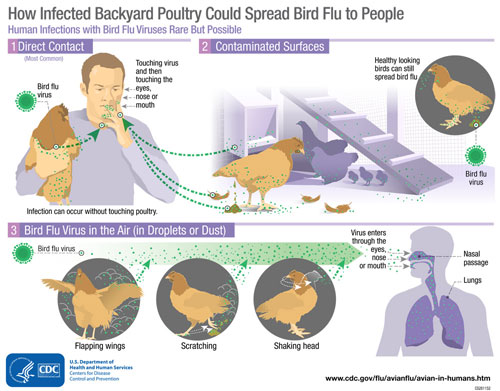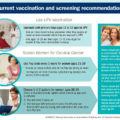Avian influenza refers to the disease caused by infection with avian (bird) influenza (flu) Type A viruses. These viruses occur naturally among wild aquatic birds worldwide and can infect domestic poultry and other bird and animal species. Avian flu viruses do not normally infect humans. However, sporadic human infections with avian flu viruses have occurred. The links below offer more information about avian influenza.
influenza viruses type A, B and C are among the causes of respiratory tract infections in humans. Type A virus has 15 subtypes some of which are predominant in pigs (swine influenza virus), in humans (human influenza virus), in horses (equine influenza virus) or in birds (avian influenza virus).
Human and animals can pass influenza virus from one to another. Humans can thus, become sick from avian or swine influenza when they pick up the virus from these animals.
In irregular intervals which can be as frequent as yearly, genetic particles of viruses from birds and pigs or humans are mixed (assortment) to produce novel subtypes with increasing virulence. The theory of the pandemic flu is derived from the expectation that such a mixture of viral materials will produce a novel influenza that will spread early in humans unhindered by a non-existent human immunity.
Influenza A viruses are classified into subtypes based on two surface proteins, the hemagglutinin (HA) and neuraminidase (NA). A virus that has a type 1 HA and type 2 NA, for example, would have the subtype H1N2. At least 16 types of hemagglutinins (H1 to H16), and 9 neuraminidases (N1 to N9) are known to exist in birds4.
Transmission
Symptoms
The symptoms of swine influenza and avian influenza in people are similar to the symptoms of regular human seasonal influenza infection and include:
Fever
Conjunctivitis
Fatigue
Lack of appetite
Coughing
Sore throat
Vomiting and diarrhoea.
Muscle ache
However, it is important to note that infection with a HPAI virus if untreated can result into a multi-organ disease including acute respiratory illness and neurologic disorder 12.
Diagnosis/Testing
Diagnosis of Human Avian Influenza infection is done through isolation of viral particles in culture of respiratory secretions (throat and nasal swab inclusive). However this technology is often not available in developing countries. It is also highly biohazardous. Commercial rapid tests which are easily applicable in the field are less sensitive.
The most used diagnostic method is real time polymerase chain reaction RT-PCR13,14, a molecular method alternative that reduces the challenges inherent in viral culture process.
Avian influenza Treatment
Antiviral drugs Oseltamivir, Peramivir, and Zanamivir have been successful in treatment of Avian Influenza A viruses. However, some evidence of antiviral resistance has been reported in HPAI Asian H5N1 viruses and influenza A H7N9 viruses isolated from some human cases 12.
Prevention & Control of Avian influenza
Prevention and control strategies for Avian Influenza include the following:
In Humans
Vaccination
Taking annual seasonal influenza vaccination is recommended to protect against seasonal influenza virus. This might not protect against any new strain.
Infection prevention practices
Those responding to or working with poultry should wearing personal protective equipment while working in communities with existing outbreak.
- Eat well cooked poultry and poultry products.
- Practice good hand hygiene
- Public Education
- Include self-monitoring for illness during and after responding to HPAI outbreaks among poultry.
- Increase surveillance
- Engender societal behavioural changes
But what are the best measures poultry keepers can take to prevent outbreaks spreading?
Keep your birds indoors at high-risk times
These prevention measures aim to keep birds separate from migrating wild birds, which are thought to spread the virus. The UN’s Food and Agriculture Organisation (FAO) said in November that all countries along the migration paths of waterbirds were at risk.
If they can’t go indoors, prevent access by wild birds to their food
However, measures to separate poultry from wild birds must be balanced with welfare. Certain birds, such as geese or ostriches, cannot easily be kept indoors. We suggests taking other measures to keep these birds separate from wild birds, like making sure their feed and water sources cannot be accessed by wild birds.
Cover your run
Even when birds are housed, a risk of infection remains, so this must be coupled with good biosecurity. Some housed birds may be able to have contact with wild birds, such as smallholding flocks in outdoor runs.
Make sure coops and other housing are kept clean
Another good move to help prevent further spread of the disease is to take extra steps to keep your coop clean, including disinfecting all bird houses on a regular basis. For commercial poultry owners, The advice is to thoroughly clean and disinfect housing at the end of a production cycle.
Limit visitors to your flock
People moving between poultry flocks and the outside world could be a key factor in disease spread if infected wild birds are in the area. We recommend reducing the movement of people, vehicles or equipment to and from areas where poultry are kept. US producers trying to limit the spread of disease in 2015’s avian flu outbreaks found that keeping essential equipment sets inside the house reduced the number of necessary trips between buildings.
Disinfect visitors and vehicles
If you can’t reduce the movement of people into your flock any further, you can still improve you biosecurity even more by taking precautions to avoid the transfer of contamination by cleansing and disinfection of equipment, vehicles and footwear. Inexpensive disposable boot covers can allow neighbours to be welcome visitors without compromising flock security,” she adds.
Reference
- Short KR, Richard M, Verhagen JH, van Riel D, Schrauwen EJ, van den Brand JM, et al. One health, multiple challenges: The inter-species transmission of influenza A virus. One health. 2015 Dec 1;1:1–13.
- Peiris M, Yen HL. Animal and human influenzas. Rev – Off IntEpizoot. 2014 Aug;33(2):539–553.
- Peiris JS, de Jong MD, Guan Y. Avian influenza virus (H5N1): a threat to human health. ClinMicrobiol Rev. 2007 Apr;20(2):243–267.
- Spickler AR. Swine influenza. Technical Factsheet [Internet]. 2016 Feb; Available from: http://www.cfsph.iastate.edu/Factsheets/pdfs/swine_influenza.pdf
- Chan PK. Outbreak of avian influenza A(H5N1) virus infection in Hong Kong in 1997. Clin Infect Dis. 2002 May 1;34 Suppl 2:S58–64.
- Chen L, Sun L, Li R, Chen Y, Zhang Z, Xiong C, et al. Is a highly pathogenic avian influenza virus H5N1 fragment recombined in PB1 the key for the epidemic of the novel AIV H7N9 in China, 2013? Int J Infect Dis. 2016 Feb;43:85–89.
- WHO | Avian influenza – situation in Nigeria – update. 2006 Feb 22; Available from: http://www.who.int/csr/don/2006_02_22/en/
- Monne I, Meseko C, Joannis T, Shittu I, Ahmed M, Tassoni L, et al. Highly Pathogenic Avian Influenza A(H5N1) Virus in Poultry, Nigeria, 2015. Emerging Infect Dis. 2015 Jul;21(7):1275–1277.
- WHO | Avian influenza – situation in Nigeria – update. 2007 Jan 31; Available from: http://www.who.int/csr/don/2007_01_31a/en/
- Beigel JH, Farrar J, Han AM, Hayden FG, Hyer R, de Jong MD, et al. Avian influenza A (H5N1) infection in humans. N Engl J Med. 2005 Sep 29;353(13):1374–1385.
- Shafir SC, Fuller T, Smith TB, Rimoin AW. A national study of individuals who handle migratory birds for evidence of avian and swine-origin influenza virus infections. J ClinVirol. 2012 Aug;54(4):364–367.
- C D C. Avian Influenza. 2016 Jun 25; Available from: http://www.cdc.gov/flu/avianflu/avian-in-humans.htm#symptoms
- Van Saventer JM, Hamer DS. From Seasonal to Pandemic Influenza. In: Hamer DS, Griffiths GK, Maguire JH, Heggenhouge HK, Quah SR, editors. Public Health and Infectious Diseases . 1st ed. USA: Elsevir; 2010. p. 394–405.
- W H O. WHO Avian Influenza Factsheet. Factsheet [Internet]. 2014 Mar; Available from: http://www.who.int/mediacentre/factsheets/avian_influenza/en/
- García-García J, Ramos C. [Influenza, an existing public health problem]. SaludPublica Mex. 2006 Jun;48(3):244–267.





